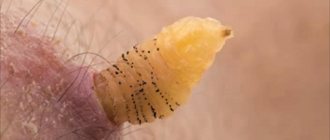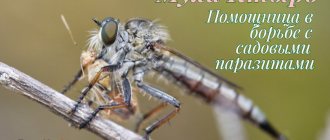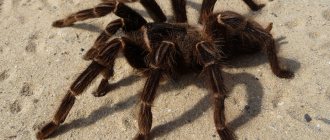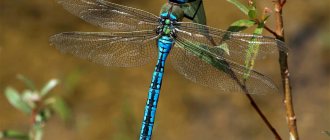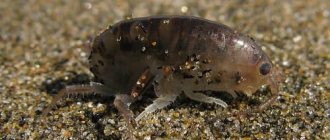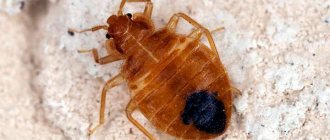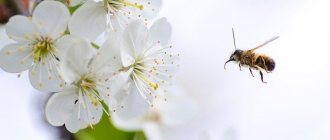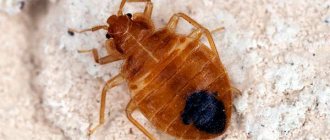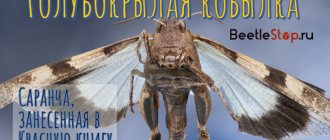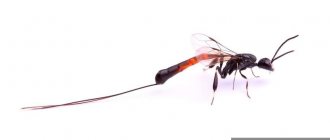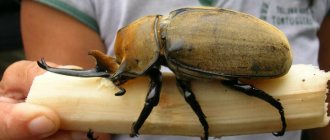Tarantula hawk wasp - a ruthless predator from the world of insects (21 photos)
The name of representatives of one of the largest wasp species is a consequence of their method of attacking prey and ruthlessly destroying it. However, the tarantula hawk wasp received this name only because it strives to care for its offspring and provide them with food.
Photo: Flickr / Crume
Photo: Flickr/Ethan Lundgaard
Reaching a length of 5 cm, the tarantula hawk wasp can cause palpitations in a person suffering from entomophobia. So, if you are already feeling lightheaded, then perhaps you shouldn’t read any further.
Photo: Flickr/Ryan.Padilla
Photo: Flickr/tribe12_mook
Asia, North and South America (southern Argentina) and Australasia are home to many different species. The sting of a female tarantula hawk is simply huge - one of the largest in the world of insects and can cause severe pain. Reaching a length of almost 1 cm, it has evolved in order to quickly cope with the wasp's main prey - the tarantula.
Photo: Flickr/graftedno1
Photo: Flickr/Dolor Ipsum
When you know exactly how a female kills her prey, you realize that Ridley Scott's concept for Alien wasn't that alien after all. After reproduction, the female has only one instinct - to provide for the next generation. To do this, she must first catch the tarantula.
Photo: Flickr / Graftedno1
Photo: Flickr / Graftedno1
Photo: Flickr/arneheijenga
She has long legs with hooked claws to capture victims, of which there will be many. Each spider can only feed one of its offspring, so there will be many casualties on the way to providing food for the next batch of spider-munching wasps.
Photo series: Flickr / Crume's Photostream
Once the tarantula is caught, the wasp stings it and the venom paralyzes the spider. She is already ready for this moment - next to her there is a hole or nest, where she drags her prey. There she will have to lay one egg on the spider’s body and leave, closing the entrance.
Photo: Flickr/Jimmsgi
Once the female leaves, her parental care ends. The larva hatches after a week. Her instinct takes over, she embeds herself into the spider's abdomen and begins to eat. The vital organs of the spider are devoured last, and as soon as the larva is saturated, it begins to turn into a pupa.
Photo: Flickr/Kretyen
Photo: Wikimedia
After a few weeks, the adult wasp emerges. Another rupture in the victim's abdomen (not the chest, as we are accustomed to in Scott's films) and the life cycle continues. Only females will hunt; males feed on nectar. However, once the female is ready to mate, she will attract the attention of the male, and then local tarantulas better be careful.
Photo: Flickr/anreheinga
Photo: Wikimedia
Who will now undertake to say that the statement “females of a species are always more dangerous than males” has no basis?
Description[edit]
The more familiar species are up to 5 cm (2 in) long, making them among the largest of the wasps, and have blue-black bodies and bright, rust-colored wings (other species have black wings with blue highlights). The bright coloring of their bodies, and especially their wings, is aposematism, advertising to potential predators the wasps' ability to deliver a powerful sting. Their long legs are equipped with hooked claws for fighting their victims. Stinger female Pepsis Gross
can be up to 7 mm (9/32 in) long, and the powerful sting is considered one of the most painful insect bites in the world. [12]
Distribution
The worldwide distribution of tarantulas includes ranges from India to southeast Asia, Africa, Europe, Australia, and America. Species of tarantulas have been observed from as far north as Logan, Utah, and as far south as Argentina, with at least 250 species found in South America.[5] Eighteen species of Pepsis
and three species of
Hemipepsis
are found in the United States,[6] primarily in the deserts of the southwestern United States, with
Pepsis grossa
(formerly
Pepsis formosa
)[7] and
Pepsis thisbe
being common.[
citation needed
] These two species are difficult to distinguish, but most
P A. grossa
have a metallic blue body and reddish antennae, which separates them from
P. thisbe
. Both species have bright orange wings that become transparent near the tip.
Sting[edit]
Tarantula wasps are relatively docile and rarely bite without provocation. However, the bite - especially the P.rossa
- is one of the most painful of all insects, although the severe pain only lasts about five minutes.
[8] One researcher described the pain as “…immediate, excruciating, unrelenting pain that simply leaves a person unable to do anything other than scream. Mental discipline just doesn't work in these situations." [5] In terms of scale, a wasp sting ranks at the top of Schmidt's sting pain rankings, second only to the bullet ant, and is described by Schmidt as "blinding, brutal, [and] shocking."[2] Due to their extremely large stingers, very few animals are capable of eating them; one of the few that can do this is Roadrunner. Many predatory animals avoid these wasps, and many different insects mimic them, including various other wasps and bees (Müllerian mimics), as well as moths, flies (such as midas) and beetles (such as traghidion
) (Batesian mimics).
Apart from the possibility of triggering an allergic reaction, the bite is not dangerous and does not require medical attention. Local redness in most cases appears after pain and lasts up to a week.
Links[edit]
- ^ a b Starr, S. K. (1985). "A simple pain scale for field comparison of Hymenoptera stings" (PDF). Journal of Entomological Science
.
20
(2): 225–231. DOI: 10.18474/0749-8004-20.2.225. - ^ab Schmidt, Justin O.; Blum, Murray S.; Overal, William L. (1983). "Hemolytic activity of stinging insect venoms." Archives of Insect Biochemistry and Physiology
.
1
(2): 155–160. DOI: 10.1002/arch.940010205. - ^ abc "Wasp Killing Tarantulas". BBC Earth
. January 13, 2015. Retrieved January 15, 2015. - Phillips, Stephen J.; Comus, Patricia Wentworth, ed. (2000). Natural History of the Sonoran Desert. University of California Press. pp. 464–466. ISBN 0-520-21980-5.
- ^ ab "Tarantula Hawks". Retrieved July 26, 2010.
- "Bug Guide - Pepsis - Tarantula Hawks". Retrieved May 5, 2016.
- Vardy, C. R. (2002). “The New World tarantula hawk wasp genus Pepsis Fabricius (Hymenoptera: Pompilidae). Part 2. P. grossa - to the groups of P. deaurata."
- Conniff, Richard (2009-08-10). "Oh, Sting, where is your death?" . New York Times
. Archived from the original on 2015-09-14. Retrieved May 24, 2010. - New Mexico State Legislature Visitor's Guide (PDF). New Mexico Legislature. paragraph 33. Archived from the original (PDF) on November 21, 2022.
State insect of New Mexico[edit]
The US state of New Mexico has chosen a species of hawk tarantula (specifically P. formosa
, now known as
P. gross
) in 1989 to become its official insect state. His choice was suggested by a group of Edgewood elementary school students conducting research into the states where the state insects had been adopted. They selected three insects as candidates and mailed ballots to all schools for a statewide election. The winner was the tarantula hawk. [9]
Tarantula wasp
- A male tarantula hawk at Grant Ranch County Park, near San Jose, California
- A paralyzed tarantula with orange knees is dragged by a tarantula hawk, Costa Rica.
- Tarantula Hawk Sting
- Blue-black belly of a tarantula hawk
Distribution[edit]
The worldwide distribution of tarantulas includes areas from India to Southeast Asia, Africa, Europe, Australia and the Americas. Species of tarantula hawks have been observed from as far north as Logan, Utah and as far south as Argentina, with at least 250 species found in South America. [5] Eighteen species of Pepsis
and three
Hemipepsis
occur in the United States,[6] primarily in the deserts of the southwestern United States, with
Pepsis grossa
(formerly
Pepsis formosa
)[7] and
Pepsis
being common.
[ citation needed
] The two species are difficult to distinguish, but most
P. grossa
have metallic blue bodies and reddish antennae, separating them from
P. thisbe
. Both species have bright orange wings that become transparent near the tip.
Hawk Wasp: Tarantula Killer. An elegant killer with an extremely painful bite
“Another Australian creature,” you say. “Don’t rush to conclusions,” I will answer you. It’s not only on the upside-down continent that there is fierce cruelty! Our guest is a brutal inhabitant of the no less brutal Wild West
.
Meet the stern master of the prairies, the menace of tarantulas and the hero of arachnophobes - the hawk wasp
!
Hawk Wasp, Tarantula Wasp - call it whatever you like, but, alas, it does not look like either a tarantula or a hawk. You will not confuse this black beast with any other arthropod: black body, orange wings and size from 2.5 to 5 centimeters
, from now on and forever you will have nightmares.
Okay, don’t rush to open a brick factory - insects are of little interest to sapiens. The hawk wasp sees the meaning of its existence in two things: procreation and the extermination of spiders
, and not just any, but the largest
representatives of tarantulas!
According to the canons of arthropods, the female is 1.5-2 times larger than the male
, and this has a direct bearing on the lifestyle and family recipe for creating larvae.
When the young lady feels that the time has come, she goes out into the open field, finds the fattest spider and challenges him. The result of the battle was an epic fatality with the penetration of a 7-mm sting into the carcass of the unfortunate tarantula
.
The poison paralyzes the victim almost instantly
.
Having dragged the prey to a secluded nest, the dominatrix lays a fertilized egg on it
,
walls up the entrances and exits and flies off to carry out further robbery
.
The hatched larva, tightly clinging to the spider, sucks all the juices from its flesh.
until he gets stronger and grows up.
But the trash doesn't end there! Having sucked enough, the young hawk wasp literally eats the tarantula alive
.
At the same time she leaves vital organs for dessert
so that her breakfast, lunch and dinner remain “warm” until victory.
As Master Woland said: “There is only the first freshness!”
.
The hawk wasp gets the fattest and largest tarantulas exclusively for its daughters
.
When a skinny and unsightly spider
, she lays
an unfertilized larva
, from which an equally skinny and unsightly
male wasp hatches.
Don’t think about it, hawk wasps are not militant feminists, they just
feed girls children, kill tarantulas, and then drag these same tarantulas on their humps to the nest
.
Be that as it may, wasps that are born, having tasted someone else's flesh, in adulthood rethink their taste preferences and switch to veganism, drinking the nectar of local weeds
.
True, the thirst for cruelty will remain with female hawk-wasps forever. Sometimes young and not so young individuals gather in groups
in order to instill terror in the crowd and sow discord.
Well, at the same time, look for resources and get acquainted
.
I hope you haven't forgotten about the 7mm sting
?
So, according to the Schmidt scale
, the injection of our spider exterminator is rated
at a maximum of 4 points
.
But don’t worry, even if you come across a particularly nervous one - their venom is not very toxic
.
Hellishly, unbearably, excruciatingly painful
, but not fatal. The risk of getting more serious injury during hysterical throwing in a vain attempt to relieve the pain is much greater.
Despite all its cruelty, the hawk wasp has found a whole cult of copycat fans. Many people want to be as stylish and dangerous as a wasp-hawk.
.
the ktyr
has gone the furthest - he imitates his idol both in color and behavior, making funny movements with his belly and sticking out his pip as if there was a sting there.
That's all. Don't be cruel like a wasp-hawk, love your mother and sleep soundly.
Source:Go
Read us on Odnoklassniki VKontakte Telegram
